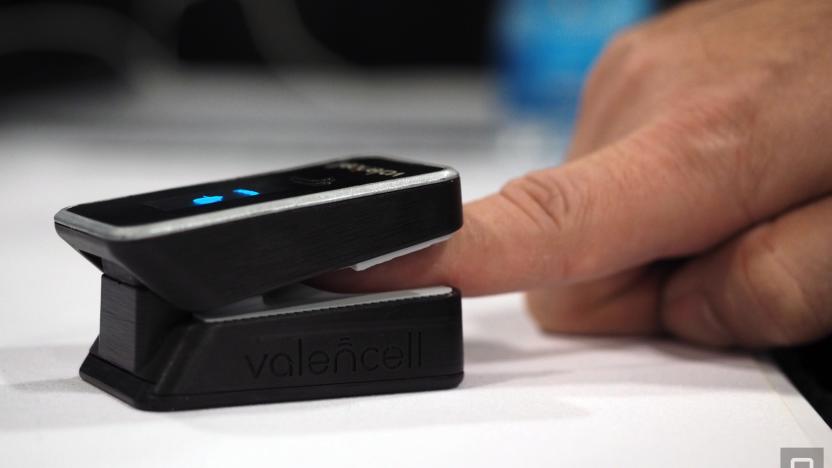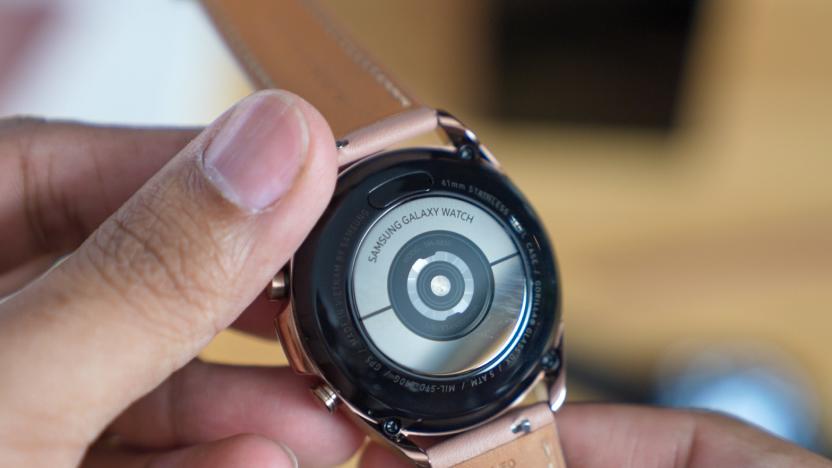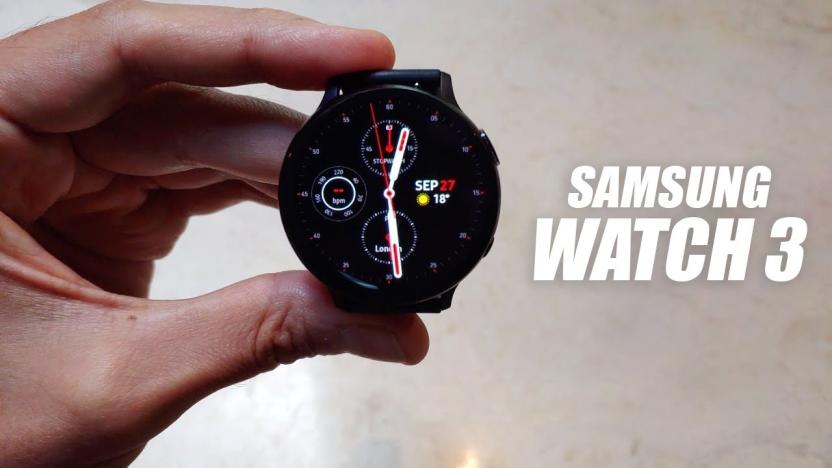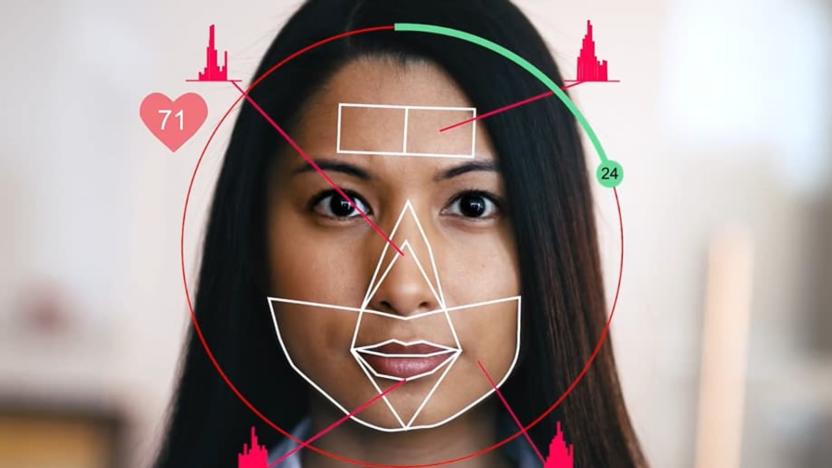Blood Pressure
Latest

Valencell promises blood pressure monitoring in a finger clip
Is this the end of the blood pressure cuff?

Samsung's Galaxy Watch 3 ECG tracking comes to 31 more countries
Samsung has announced that it’s expanding the ECG and blood pressure tracking features in its latest Galaxy Watch models to the UK and Europe, along with Chile, Indonesia and the UAE for 31 new countries in total.

Samsung's Galaxy Watch 3 supports ECG, but only in South Korea for now
Most notable is the electrocardiogram (ECG) feature, something Apple added to the Watch series 4 in 2018. ECG isn’t available at launch, but Samsung says it’ll be available soon on both the Watch 3 as well as the Watch Active 2. Samsung is also including blood pressure monitoring in the Watch 3, something not available on the Apple Watch.

Samsung Galaxy Watch 3 leaks again in detailed hands-on video
We already knew a few details about Samsung’s Galaxy Watch 3, but a new video from TechTalkTV (via The Verge) appears to reveal most everything else you need to know about it.

Samsung's Galaxy Watch Active 2 gets blood pressure monitoring
The Galaxy Watch Active 2 just got even more useful.

Researchers find way to measure blood pressure with a selfie video
In the near future, you might not have to traipse to your doctor or pharmacy to determine your blood pressure. Researchers have figured out a way to accurately measure it with your phone's camera.

Archos previews connected home, health monitoring devices ahead of CES
Archos looks to be getting in on the New Year's resolutions a bit early. The company clearly couldn't wait for CES to spill the beans on its 2014 lineup -- at least so far as connected devices are concerned. The device maker wants to make you a part of its internet of things, previewing a slew of devices, including an activity tracker, scale, blood pressure monitor, weather station and tablet. There is, predictably, not a whole heck of a lot of information on any of the products -- in fact, the company's managed to shove mentions of all of the above into a single press release issued a little more than a week out from the big Vegas event. Archos is collectively referring to the lineup as its "connected objects" -- devices that are monitorable in real-time via Android and iOS apps. There's not much to say about the 7-inch Smart Home Tablet, at the moment. The company's positioning the Android device as a "gateway" to connected home actions, like turning on lights and recording video with a mini-cam when a motion sensor is triggered. CES will also see the debut of a new Weather Station from Archos, offering up indoor and outdoor temperature, humidity, CO2, pressure and other readings, along with national and historic levels for comparison. The company's Connected Self app, meanwhile, was built to work with a handful of new health devices. The list includes a connected scale that tracks body fat, an activity tracker that measures footsteps and burned calories and a blood pressure monitor that comes with an irregular heartbeat detector.

Samsung launches S Health services: Monitors weight, blood sugar and graphs it all
Samsung mentioned its S Health app in passing during the grand unveiling of the Galaxy S III -- presumably due to the glut of similarly S-suffixed apps and services that were also unveiled. The service has now apparently launched in Samsung's homeland, alongside more details of what it'll offer. This includes a raft of metric-measuring charts, as well as the ability to connect through Bluetooth and USB to health devices like heart-rate monitors and connectivity-friendly scales. The app will record and even graph your health ups and downs, aiming to help "regulate" what you eat and gauge exactly how much you exercise. It has now launch on Samsung's App hub and will make its way to the US and five to-be-confirmed European countries soon. Let Samsung explain the "warm emotional experience" in a Google-translated release right after the break. Update: We've just received the English version of the PR, which adds that the app is now live in the UK, alongside an initial list of compatible health devices. Take a look after the break.

Google Health's New Year's Resolution is to cease to exist, countdown begins to save your data
Back in June, Google announced that it would be 'retiring' Health effective January 1, 2012. Now, everything appears to be on-track for the shutdown, with Google sending out a final reminder to Health customers earlier today. You have until the stroke of midnight to access the service or port your data to a competitor -- after which point you'll no longer be able to view information saved to your account, though it'll remain available to download in .zip format for another year. Want to know more? Hit up the source link for the Google Health FAQ.

Google 'retires' Health and PowerMeter, lets you save your vitals through 2012
Remember that Withings blood pressure monitor for iOS that we went hands-on with last week? It integrated with Google Health. The search giant's health management portal also paired with dozens of other services (a heaping handful can be seen in the image above) to aggregate and track all of your data, and share it with family members, friends, and doctors. The service didn't have the widespread impact that Google expected, however, so it's taking Health offline after the clock strikes midnight on January 1, 2012. You'll have another year to download your info, or send it directly to competing services. Also on the chopping block is PowerMeter, a free energy monitoring tool that pairs with smart power meters and other energy monitoring devices to help users better understand consumption habits and ultimately reduce costs. That project will get the boot from Mountain View on September 16th, but you'll be able to log in to your account to download a CSV file. We imagine Health and PowerMeter are already plotting their trip down south, to get in a few thousand rounds of golf with Video Store at Pebble Beach. Perhaps to be joined by Buzz and Wave, in the not-so-distant future?

Withings Blood Pressure Monitor: An iOS-friendly way to track your BP
Withings is a company with an interesting mission -- making it possible to send health information directly from measuring devices to the internet, where the data can be shared with personal computer and mobile apps. The company has just started selling its new Blood Pressure Monitor (US$129.00) in the United States, and over the weekend I tried one out. I already have a Withings Wi-Fi Body Scale ($159), and I find it to be an indispensable part of my daily health regimen. I step on the scale every morning and let it blast my weight to the Withings website. I've been using one of the many Withings-compatible iOS apps, Weightbot ($1.99) by Tapbots, to monitor my weight fluctuations. I can also visit the Withings website to look at the raw data, share it with several services, like Google Health or Microsoft HealthVault (I use neither), or create a PDF of weight and blood pressure to send to my doctor. %Gallery-126682% Setup Probably the coolest thing about the Withings Blood Pressure Monitor is that it is made to work only with iOS devices. If you have an iPhone, iPod touch or iPad, you're set. The setup process is incredibly simple -- you just unlock your device, if you have a lock screen set up, and then plug the cable into the Dock Connector on the iOS device. Chances are pretty good that when you start using the Blood Pressure Monitor, you won't have the free WiScale app on your device, so the monitor "tickles" your device to see if the app is there, and sends you to the App Store to download it if is not. WiScale is designed to display your weight and blood pressure history, and it's also the app that runs the Blood Pressure Monitor and captures the BP data for you. To send the health data to Withings for sharing purposes, you need to either set up a new MyWithings account through the app or use an existing login. That's pretty much it for the setup, as the monitor comes with four AAA batteries pre-installed. There are no Wi-Fi settings to make, since your iOS device is used to send the blood pressure data to Withings. Taking your blood pressure As with any blood pressure monitoring regime, you should plan on taking your pressure with the Withings Blood Pressure Monitor at the same time each day for consistency's sake. I chose to take mine first thing in the morning. Your monitor has a cuff with a nice springy curl to it and the standard Velcro patches to make sure it is tightly attached to your upper arm. The electronics for the device are in a polished aluminum tube on the cuff that also aligns the cuff on your arm properly. Per the instructions that are printed on the tube, you align the cuff with the pulse point on the inside of your elbow, with the cable pointing down towards your iOS device. With the WiScale app launched and the iOS device plugged into the monitor, a blank blood pressure screen appears. You can either press the large green Start button to begin the process or switch users and then press Start. The display on the iOS device shows that a measurement is underway, and a small fan icon begins to turn as the pump inflates the BP cuff. Eventually your pulse appears as a beating heart icon, the cuff begins to deflate, and finally, your diastolic and systolic blood pressures and pulse rate are displayed. At that point, you can tap the blue Done button to quit or press Start again to take your pressure again. There's also an auto mode, which takes your blood pressure three separate times (with a pre-set time period in between each test) and averages the readings. Viewing the results After the blood pressure reading has been made, you get immediate feedback. If the diastolic and systolic blood pressure readings are in the normal range, a green dot appears next to the number. Likewise, if your pulse appears to be in the normal range, you'll see a green dot next to the beats per minute count. For any of the readings, a yellow dot is sign for concern, while a red dot indicates a situation that you may wish to share with your healthcare provider. There's a "thumbwheel" at the bottom of the results to scroll back and forth through your BP readings. If you're bringing in weight data from a Withings scale, you can see your latest weight and that day's BP reading by flicking between two screens on the display. Remember that the app has also sent a copy of that blood pressure reading to the Withings site, and it's easy to share that and your weight data with a health professional or personal trainer. Conclusion For anyone with a family history of high blood pressure who wants to keep track of his or her BP automatically, the Withings Blood Pressure Monitor is a worthwhile and easy-to-use tool. Having used a lot of less expensive cuffs in the past, I can't say that the Withing monitor is going to give you any more accuracy or make your BP magically go down, but it does make keeping track of your blood pressure history a snap. I found the device to be faster than many less expensive cuffs, and I like the three-reading average that is available in auto mode. If you're a middle-aged guy like me whose background includes many ancestors with heart and blood pressure problems, your doctor has probably told you to keep an eye on your BP. The Withings Blood Pressure Monitor, coupled with your iPhone, iPad or iPod touch, is a fast and fun way to get into that healthy habit and share your information with your healhcare provider.

Withings Blood Pressure Monitor for iOS hands-on (video)
Withings users not satisfied with only being able to share their weight with the world can now add blood pressure and heart rate to the mix. This iPhone-connected blood pressure monitor made its first appearance at CES, but you'll finally be able to order one of your own today. Compatible with iPhone, iPad, and iPod touch, the $129 accessory costs three to four times as much as off-the-shelf blood pressure monitors, but integrates well if you're looking to pair it with your Withings scale for a complete vitals management solution. Results can be sent to health sites like Google Health and Microsoft HealthVault, or directly to your doctor. Care to see how it works? Join us past the break for a hands-on look at the monitor, including a video comparison with the in-store vitals machine at our neighborhood Kmart. Update: Withings wrote in to let us know that the blood pressure readings in the video below were likely inflated because we were talking, though we do appreciate the concern you've already expressed in the comments.%Gallery-126616%

Blood turbine to power your pacemaker, become legendary band name
Why bother with risky battery-changing surgical operations when your own cardiovascular system can provide all the power your heart-shocking pacemaker will ever need? Engineers at Switzerland's University of Bern have been working on tiny turbines; turbines small enough, in fact, to fit inside a human artery. Working like a blood powered hydroelectric generator, a working prototype -- tested in a simulated artery -- has been able to produce 800 microwatts of electricity. That's roughly eighty times the power required to power the average pacemaker; such a device could provide independent, sustainable power to neurostimulators, blood-pressure sensors, and other implanted medical gizmos. Researchers are concerned, however, that a blood turbine's adding agitation of blood flow might lead to clotting, and are continuing to tweak and rework the design to minimize this risk. Similar, but unrelated cardiovascular power designs have attempted to alleviate the concern by doing away with the rotating, fluid powered components, opting to generate electricity by oscillating magnets by utilizing changes in blood pressure -- which sounds awesome, but still falls shy of "blood turbine," in the contest for most Metal medical device.

Withings fittingly debuts iPhone-connected blood pressure monitor at CES
Trust us -- no one on the Engadget staff wants to know what their blood pressure is right about now. For those trapped in the hurricane that is CES, there's probably no better product to have laying around than this... but only if you're looking to confirm your suspicions about being in a high-stress career. Withings, the company best known for its connected scales, has just revealed the planet's first iPhone-connected blood pressure monitor, with an aim to make measuring vitals as easy as pie for iOS users. The idea is fairly simple: just plug the arm band into your iPad, iPod touch or iPhone, dial up the gratis app and start the process. All of the data is logged on the user's secure online space, and there's even a secure sharing feature that'll beam your abnormally high rates right to your frightened physician. It'll go on sale tomorrow around the globe, with the asking price set at $129 / €129. Update: Looks like iHealth beat these guys by a dozen hours or so. Splitting hairs, but there it is. %Gallery-112205%

iHealth, Withings both launch iPhone-connected blood pressure monitors
There are lots of solid therapeutic approaches to treating hypertension (high blood pressure), and they range in cost and complexity all the way from free and easy up to expensive and elaborate. While it might cost tens or hundreds of thousands of dollars to treat a heart attack, it's much simpler and cheaper to focus on prevention through diet or medication -- plus monitoring blood pressure every day to make sure the plan is working as expected. Cheap and easy sounds good, but getting it done is another matter. "When dealing with patients and asking them to make a lifestyle change, one of the biggest problems is compliance," says Dr. Andrew Brandeis, a San Francisco physician. "I can either give you a pill for your blood pressure or tell you to eat less salt, and one of them is going to be easier than the other -- one of them is better than the other. But getting people to exercise more, to eat less salt; it's not always easy to get them to do what they need to do." That's why Brandeis is excited about the new iHealth blood pressure monitoring system, introduced today in the runup to CES; competitor Withings has also announced a similar product. Both cuffs provide a new level of convenience to the digital blood pressure monitor market, enabling far more granular intraday measurements that let you know exactly how various daily activities (a meal, a cup of coffee) affect your inner equilibrium. %Gallery-112496% %Gallery-112498%

iHealth blood pressure iPod dock: another sort of Apple to keep the doctor away
Back in March 2009 at the iPhone OS 3.0 debut event, Apple's Scott Forstall pointed out medical devices specifically as one of the more interesting class of peripherals that could leverage the new custom app interface capabilities. And while it's certainly an interesting concept -- keeping tabs on your general health from the comfort of your own home -- we haven't really seen it catch on (only a couple of products come to mind). That isn't stopping iHealth; the company's blood pressure dock, available today from its online store (we're told it should be filtering through Apple's own channels later this month) ties in with a specialized iPhone / iPod touch / iPad app to monitor and track blood pressure from the comfort of your home, where theoretically there shouldn't be a stranger in a white coat making you extra nervous. In our brief time with the device, the interface seemed fairly intuitive and the whole process simple and not at all intimidating. The cost of entry is $99.95 for the hardware; the free app should be hitting iTunes today. Press release after the break. %Gallery-112421% %Gallery-112422%

Wearable blood pressure monitor: portable and fashionable
We've seen some wild ideas when it comes to blood pressure -- including, yes, underpants -- but this newest device, a small monitor attached to the hand, which can be worn 24 hours a day for continuous monitoring, strikes us as having the potential for extreme usefulness. The monitor works differently than regular old blood pressure cuff, using a method called pulse wave velocity, which measures the pulse at two points along an artery. Built by a team of engineers at MIT, this prototype could boast a lot of advantages over monitors, including its portability, its ability to see long-term patterns of rises and falls in pressure, and of course -- you wouldn't have to be at the doctor's office to use it -- which is bound to take a little stress out of the equation. The device is moving toward commercial production and Harry Asada, leader of the MIT team, sees the possibility for monitoring conditions such as sleep apnea in the future as well.

No Cuff automated blood pressure monitor proves that you can go home again
What if you could relive all the magical moments of your childhood, like playing with the blood pressure machine at your local supermarket? Now, thanks to the personal, portable No Cuff Blood Pressure Monitor, you can. Just slide your hand in and press the button to inflate -- it's that simple. In addition to the hours of fun you're sure to have as you feel the device lightly squeeze your arm, the blood pressure reader comes with a detachable LCD display that stores as many as ninety readings, offers AM/PM systolic averaging, an irregular pulse indicator, an alarm, and an arm-movement indicator to keep you from lousing up the reading. Not bad for $200, eh? And if you're feeling generous, maybe you could share this with a sick relative, an elderly neighbor, or anyone who might need to need to check their blood pressure regularly. That is, unless their underwear already does it for them.[Via Engadget German]

Philips dreams up underwear-infused blood pressure monitoring system
Before long, hardware-laden undergarments will be a necessity in life. After all, we've already seen underwear that fends off cellphone radiation, and now Philips is looking to create a pair that actually monitors one's blood pressure continually. A recent patent application from the firm details a "wearable" system, but it does point out that "it is particularly suitable for implementation in a continuously wearable undergarment with integrated measuring sensors or electrodes, so as to be directly in contact with the subject's skin." We can only assume that if these actually make it beyond the drawing board that they'll have an integrated wireless module in order to beam out vitals at all hours of the day, but we're personally a little wary about having all this hardware so close to, um, our hardware.[Via NewScientistTech]

Georgia Tech researchers design nanowires to monitor blood pressure
If you see yourself taking an unwanted trip to the ER anytime in the next decade or so, there's a fairly decent chance you'll end up with at least one or two creepy creatures perusing some aspect of your innards. As if mechanical beings cruising through your intestines wasn't eerie enough, a team of Georgia Tech researchers have proposed a new way to constantly monitor one's blood pressure. The aptly-dubbed nanowires take advantage of the "piezoelectric effect in semiconducting zinc oxide" in order to detect minute forces as tiny "as a few piconewtones," or about the same amount needed to unzip a strand of DNA. The specially designed sensors will purportedly enable robotic nurses to continually monitor your blood pressure to take action before things get too out of hand, and of course, the "biocompatible "system would beam results wirelessly to devices in hospitals or even wrist-mounted readers so you'd know when to pop a proverbial chill pill. This should definitely suffice as a "second opinion," eh?











